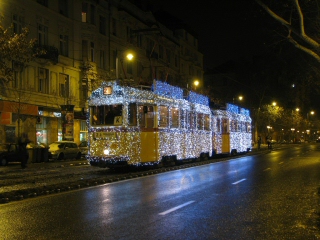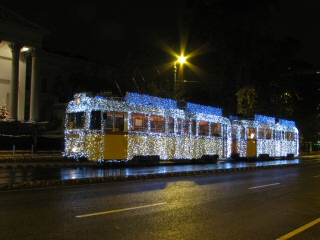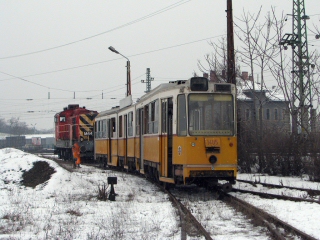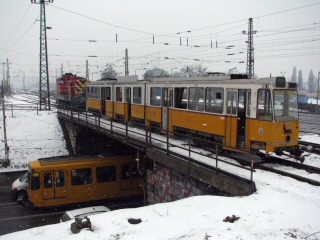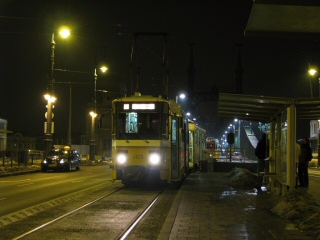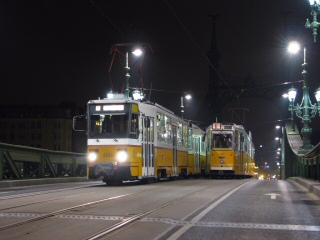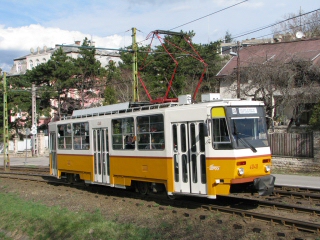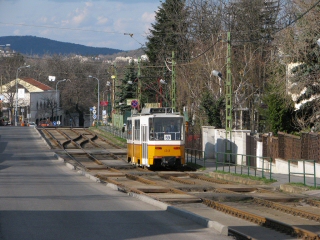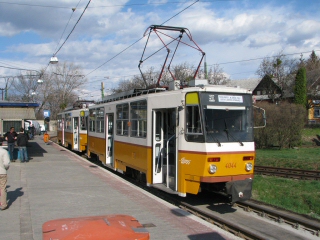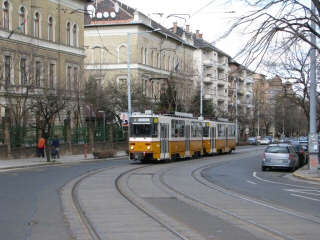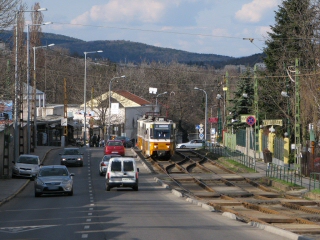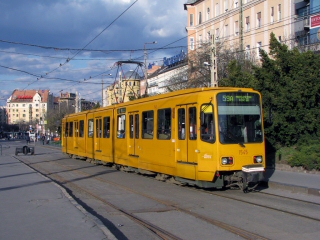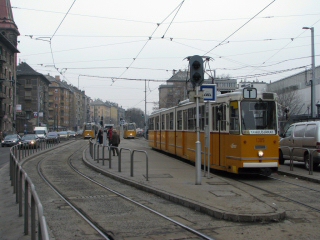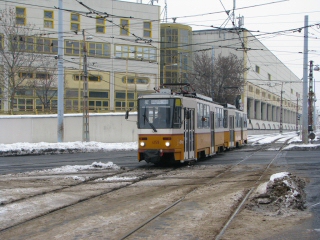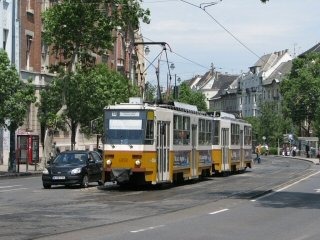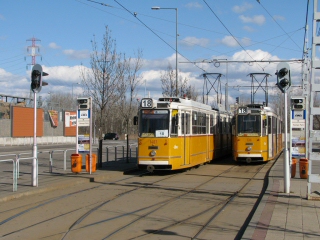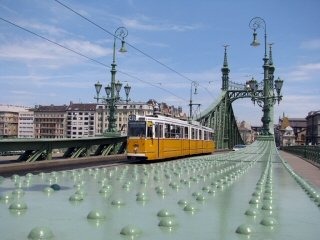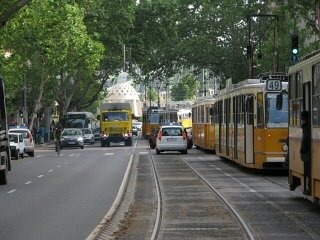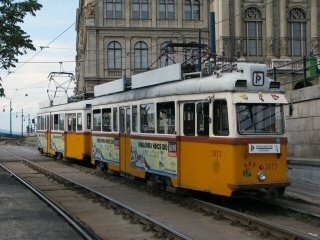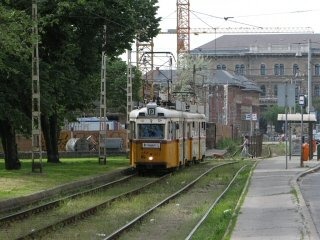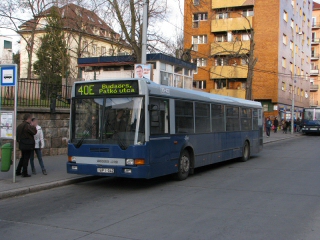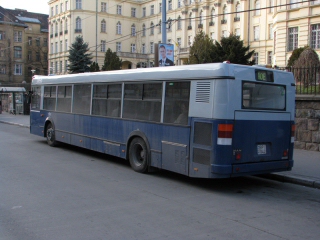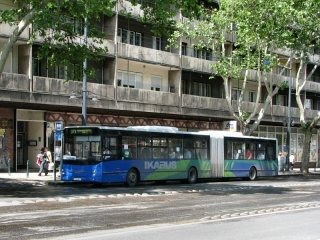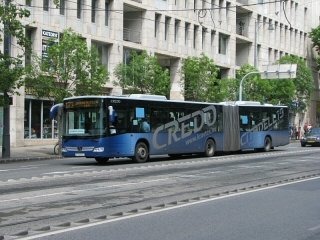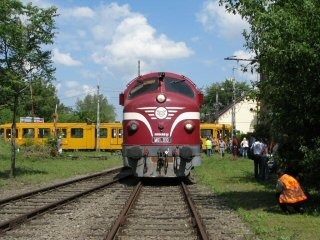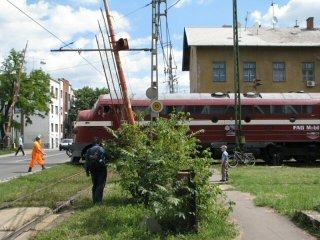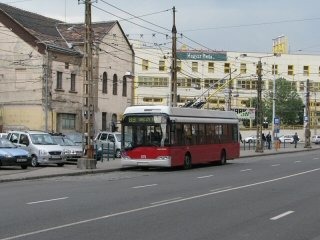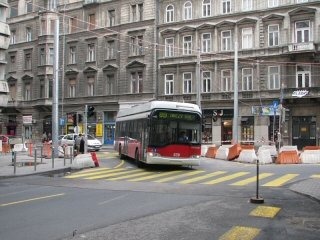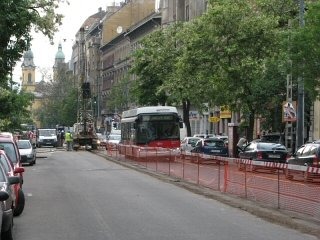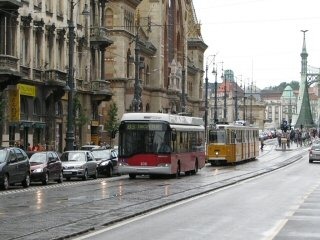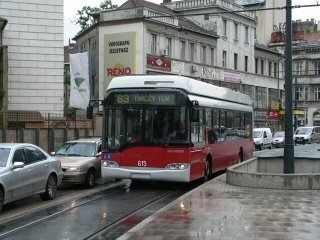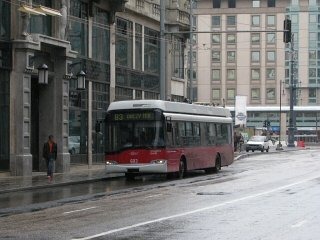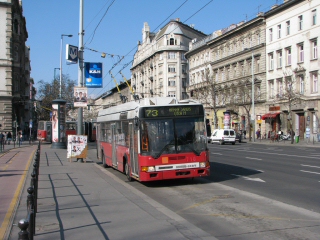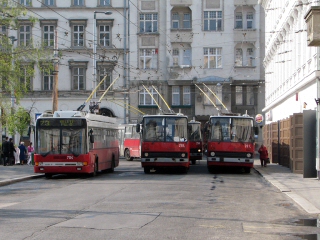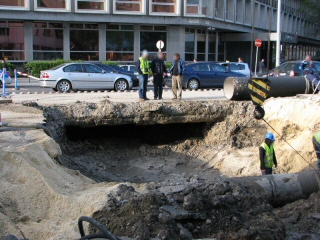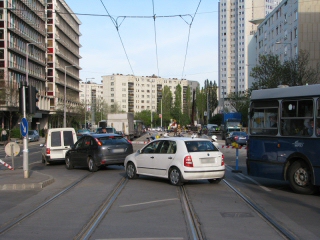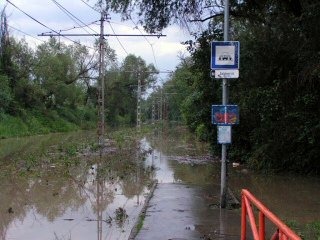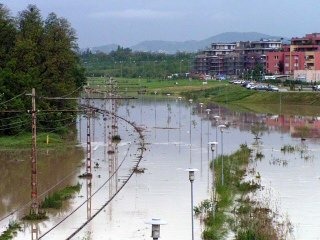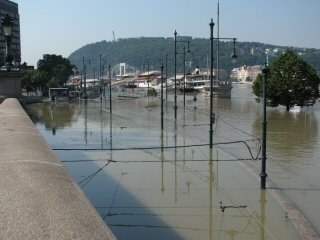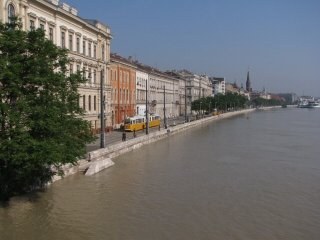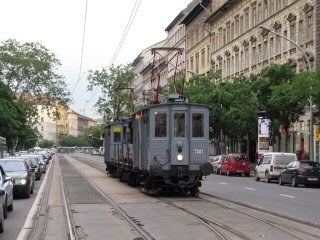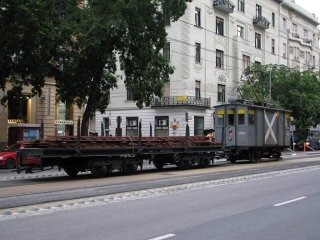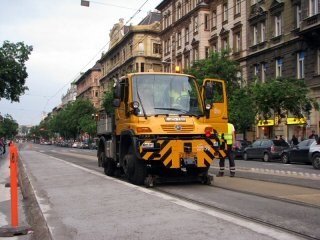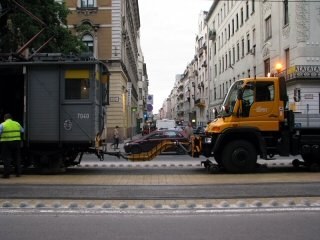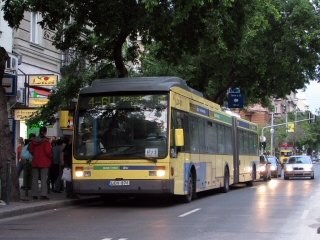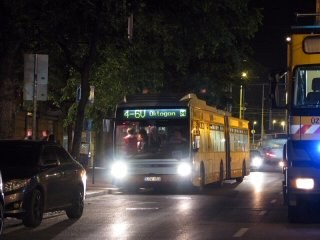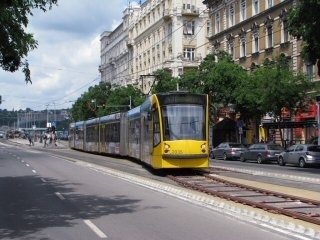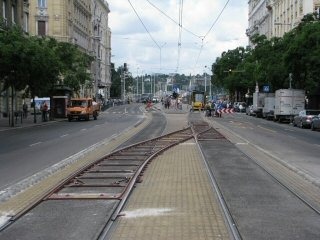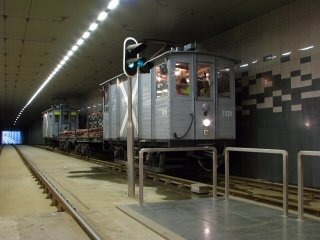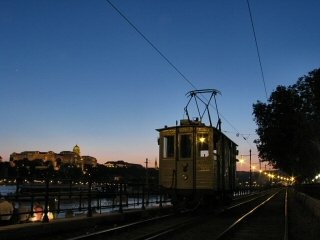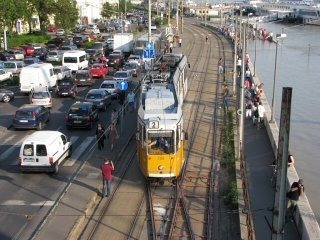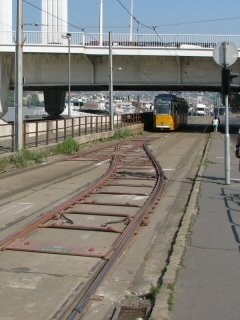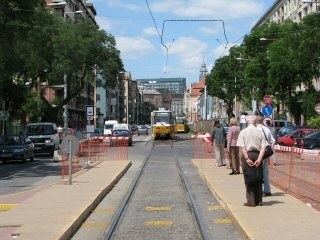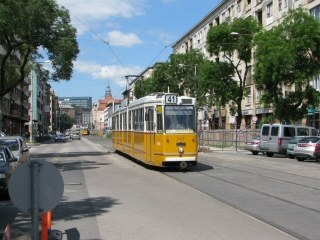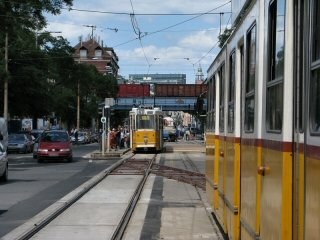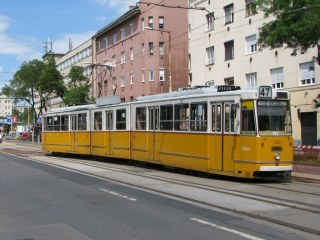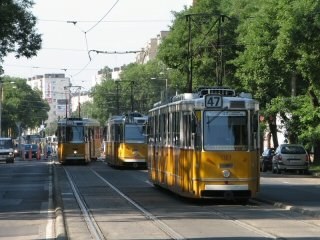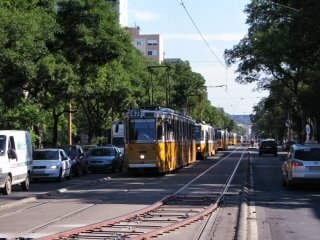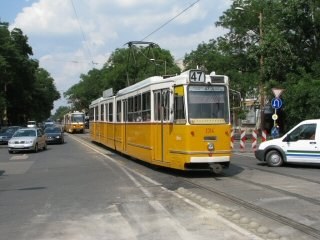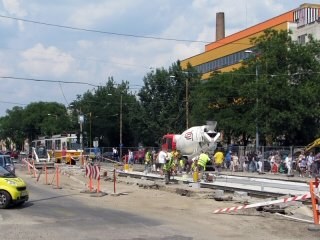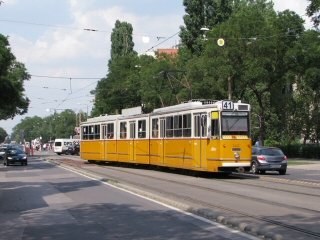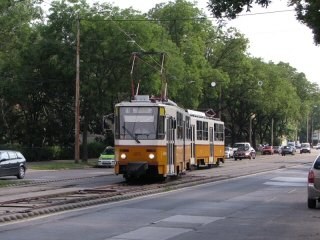budapest
other hungarian
close-up
lost rails
other countries
Hier geht's zur deutschsprachigen Version / Kattints ide a magyar változathoz
It was a long and hard winter, which turned into a rainy and cold spring, and then a summer with tropical storms. In the pauses between these I took some pictures - here's a slection of them.
The Christmas Tram was sent-off with an excursion to the Small Boulevard, mainly for the tram photographers (left: Bartók Béla út, right: at the National Museum in Múzeum körút). It's a pitty that only a few days later this decoration (consisting of 26,000 LEDs) was removed!
The new year has started badly for some vehicles: Ganz articulated number 1405, which got damaged in an accident in May 2007, was found to be beyond repair, and deleted from stock. On these pictures we see it being towed to the scrapyard over the sidings at Sörgyár. Below runs an ex-Hannover TW6000 of route 3 or 62.
The first non-hungarian tram in Budapest in almost 100 years started its revenue service on February 1st, 1980 on route 59. It was the CKD Tatra T5C5. The BKV wanted to celebrate this anniversary in February, but they had to postpone it to late March because of the cold and snowy winter.
One of the highlights of the celebrations was a visit where Tatras were never operated: the Small Boulevard (=the joint section of route 47 and 49 on the Pest side), which is bound to be a no-Tatra area because the Liberty Bridge (Szabadság híd - to the right) is too narrow. Prior the special ride a test run was conducted, this is what we see above.
There was an open day at Remise Szépilona, where the first Tatra routes (59 and 61) were housed in 1980, but I think the two "retro-style" units on route 59 were much more interesting. "Retro", becase back in 1980 they used formations that were never again used: for example, single units, like seen above.
The other nostalgic formation was two cars being coupled back-to-front (Budapest only used back-to-back coupling previously - and afterwards). This means there is no driver's cab at the back end of the two-car unit. Interestingly even though route 59's inner terminus (Moszkva tér) was rebuilt and recently moved (to Szent János kórház), the line had reversing loops at both ends back then, and has reversing loops at both ends even now (which is pretty special, since most remaining loops were abandoned during the last 3 decades), so reproducing these unidirectional units posed no problems. The photos were taken at Márton Áron tér (left) and Böszörményi út (right).
Two more photos - to the left: the back-to-front (or as we say: AB+AB) unit passing the main entrance of the Farkasrét cemetery. To the right: on its way from the open day in Remise Szépilona, ex-Hannover car number 1545 took a round trip on route 59. It's seen here after arriving to Moszkva tér.
Left: a number of coupled Ganz articulated units were assigned to route 4 during the renovation of Margarite Bridge (Margit híd). This means that they are not a rare sight along the Combinos. But when this training car ("T") arrived to the terminus at Fehérvári út, the scene did look a bit nostalgic :) To the right: depot run of route 37A at Orczy tér.
To the left: route 18 is normally operated with Tatras (seen here in Bartók Béla út). However, on the national holiday March 15 they were substituted with Ganz artics, because the line was detoured to Batthány tér, and the thick Tatras would have been unable to pass through the narrow underpass at the bridgehead of the Chain Bridge (Lánchíd). On the picture to the right, we see the terminus Savoya Park.
A short video of Budapest trams.
And now: the larch. I mean... a bit of the rack railway (tram line 60).
Normal traffic on the Liberty Bridge (Szabadság híd), and not so normal traffic near Szent Gellért tér.
Trams on Liberty Bridge by daylight and in the night. I love this bridge!
The Christmas Tram was replaced by the "Springtime Tram" on route 2. I think the former looked waaay cooler. Before you ask: the letter "P" stands for "Pest" - last year's summer special line was called "B" for "Buda". Normally, "P" stands for test run ("próbajárat")...
The BKV started to renovate is "not so old, but already quite worn" Ikarus 412 low-floor buses. Looks better now, but some cleaning would be still welcomed...
During May two hungarian buses did simultanous test runs on various BKV lines: an Ikarus V187 to the left, and a Credo 19 to the right. They look pretty alike to me!
The six-axle diesel-electric engine M61 010 belonging to the "Nohab-GM Foundation" took a small trip to the now disused freight station Kőbánya-Hízlaló. It was a great opportunity to take photos of a railway locomotive with the trams of route 3 in Bihari utca in the background!
A lovely machine this is, I must say!
The trolley bus line in Baross utca was already closed once (in 1973), but then it was relaunched (on a slightly different route). Nowadays it faces constant problems because of the construction works of the M4 metro line at Fővám tér and Kálvin tér.
With said two squares being a mess, trolley bus line 83 has been operated with buses for years, and a shorter trolley line 89 was also started between Orczy tér and Kálvin tér. When the overhead wires at latter were to be dismantled, the line was detoured and operated with Solaris/Ganz trolley buses that can run without overhead wires, too (on battery power).
Short video of these vehicles on the stretch Üllői út - Névtelen utca - first few blocks of Baross utca.
To the left: more "wire-less" running in Baross utca between József körút and Orczy tér because of road works. To the left: now these vehicles were assigned to trolley bus line 83, while line 89 was abandoned. Line 83 still has a fair ammount of running on batteries, of which the most interesting is the stretch between Fővám tér and Kálvin tér, where trolley buses use the right-of-way of the tram (seen to the right).
Left: arriving to Kálvin tér. Right: the start of Üllői út, where the vehicle switches back to overhead wire.
This mixed operation is very likely to last for a few years, because allegedly Fővám tér will be only completed when the metro line M4 is ready. And who knows when that will be!
Two photos of normal trolley buses: Ikarus 412T and 280GVM at Arany János utca.
Breakdowns, accidents and temporary closures
Tram-jam on Szabadság híd after an accident.
One night a large water pipe blew, turning Október 23. utca into a swamp, undermining the street and the tracks of route 4. The tram was stopped, and replacement buses were stuck in the traffic jam resulting from closure of half the road surface.
The outer section of route 41 im Kőérberek looked even worse when the brooklet next to the tracks turned into a river after a storm. Fortunately after the water was let down, they found out that the trackage was mostly unharmed, and traffic soon resumed.
The Danube also flooded the lower quays, but fortunately it stopped there. Of course water level was still high enough to fill the underpass of route 2 at the Chain Bridge (left), but on the other side of the river, routes 19 and 14 were not affected (to the right).
The usage of portable crossovers ("Kletterweiche" or Californian switch) is relatively common in Europe, but not in Hungary. The ice broke when the BKV bought two such devices, but it seemed they'll never have the confidence to actually use them. This was when the Association for Urban and Suburban Transit (VEKE) intervened, so at last we had a "first performance"! The occassion was the replacement of the tram tracks on Margarete Bridge (Margit híd): during the grand renovation of the bridge, trams were moved from the middle to the south side, and then to the north side. With the portable crossover, trams could reverse at Jászai Mari tér, while the southern temporary tracks were disconnected and the northern (also temporary) tracks were connected.
The portable crossover was transported to Jászai Mari tér on the ancient 4-axle flat-car number 8330. I don't know how old it is, only that the bogies are supposed to be newer than the rest: they were originally used on a HÉV (suburban railway) coach type P XII, which was built in 1928. The flat-car was towed-pushed by two "Muki" tractors: no. 7061 and 7040.
During the installation, power in the overhead had to be switched off. The rail-bound oldtimers were then moved by the Mercedes-Unimog two-way works car of the BKV. The Mukis were built in 1926/27, so that special coupler in the middle spans about 80 years :)
During the closure, trams were supplemented with ex-Belgian vanHool buses. Normally these run in South-Pest only.
The portable crossover in usage.
Speed was limited to a max of 5 km/h on the device - it seemed to take forever for the 54-meter Combino to cross it :)
As mentioned previously, route 2 had had to be shortened due to the flood. One day after the first one, the second portable crossover was installed at Március 15. tér.
To the left: the Muki + flat-car + Muki transport in the subway stop of route 2 at Fővám tér (interestingly this day number 7039 was used instead of last day's number 7061). To the right: one of the Mukis with Buda Castle in the background.
The sight of a Muki on route 2 is always special. Two Mukis with a flat-car - wow! Two Mukis with a flat-car running on the wrong side: priceless!
This is how the installed portable crossover looked like. Note the flooded lower quay in the background.
A short video of the portable crossover. Note the people below taking photos of the procedure :)
The flood went away, tram traffic on the new temporary tracks of Margarite Bridge has resumed, and the portable crossovers were already needed elsewhere: this time in Fehérvári út, at the crossing with Hamzsabégi út and Dombóvári út. Here, tram lines 18, 41 and 47 reversed on the northern and southern side of a construction pit. Above we see the northern side...
... and this is "south of the pit".
Less than two weeks later another construction site disrupted tram operation in Fehérvári út: this time at Andor utca. Unfortunately crossing vehicular traffic disturbed the reversing process even further, so queues were common.
To put it short, it was quite chaotic. Depicted are the northern "Kletterweiche" (left), the construction site (right), ...
... and the southern side. It was fun to see how the Ganz artics were twisting as they were running on the portable crossover, but it also became clear that one stub track is not enough for a busy mainline like Fehérvári út, with 3 routes running at different intervals.
And that's all for now.
Back to the top Back to the main page
